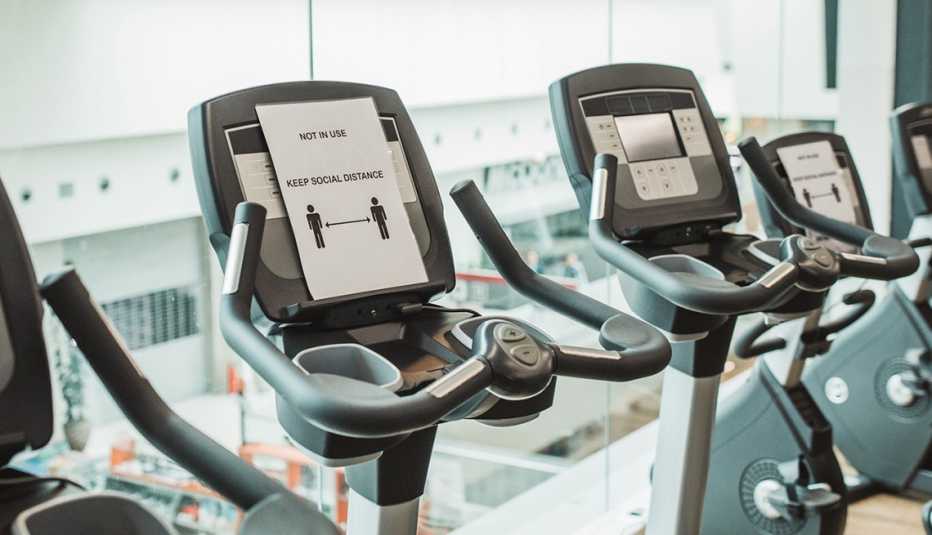Staying Fit


When the Cooper Fitness Center (CFC) in Dallas reopened in May, Cooper Stuart didn't think twice about returning, even though he's in the high-risk category for COVID-19 given that he's 68. A longtime daily gymgoer, Stuart says the virtual classes the facility launched at the start of the coronavirus lockdown simply can't replace the joy he gets from human interaction.
“The excitement of returning feels like going back to college after summer vacation,” he says. “You form a connection with members and employees and look forward to seeing them."


AARP Membership— $12 for your first year when you sign up for Automatic Renewal
Get instant access to members-only products and hundreds of discounts, a free second membership, and a subscription to AARP the Magazine.
CFC's affiliation with the nationally recognized Cooper Aerobics Center and its preventative medicine practice, the Cooper Clinic, gave him peace of mind, Stuart says, as did the gym's regular updates on safety measures it would be taking upon reopening. As some states begin to approve the reopening of gyms, fitness enthusiasts like Stuart eager to resume their regular workout routines are debating whether it's safe to return, with “yes” and “no” camps emerging.
With good reason. Research findings such as these give Henry Chambers, a professor in the Division of Infectious Diseases at the University of California, San Francisco, serious pause: A study in Japan found that the risk of infection indoors is almost 19 times higher than outdoors and a recent study by infectious disease experts in South Korea suggests that fitness centers may accelerate the spread of the coronavirus.
Before You Hit the Gym
We asked experts what to consider before you take your workout back to the studio.
1. Do you have any pre-existing medical conditions that would make you more vulnerable to complications from COVID-19? A healthy 70-year-old is less at risk than a 70-year-old with heart problems or diabetes, says Chambers.
2. Lauren Korzan, southeast regional director for Aquila, a fitness management company, says every gym should have a plan of action for when and if a member who has been to its facility reports he or she has COVID-19. They may have contracted it elsewhere but they have still been to your gym, she says. Will all members be alerted?
3. In the case of emergency, people should not be performing mouth-to-mouth resuscitation now, says Korzan. Is your gym's staff certified in hands-only CPR? Or does it have a manual resuscitator?
4. If you're in a higher-risk age bracket, Jagim says enquire about peak times of visitation and schedule around those.
5. Ask what types of cleaning products the gym is using and how often staff is cleaning, says Jagim. Cleaning products should comply with CDC recommendations.
"Gyms have a lot of factors that make them one of the last places you want to go right now,” Chambers says. “You have shared equipment, people breathing heavily, questionable air flow.” He feels getting outside to exercise is the smarter choice, especially if you're older and at greater risk of complications caused by the virus.
Tracy Jennings-Hill, owner of LiveURYoga, a 1,900-square-foot studio in Roswell, Ga., struggled with the decision to stay closed after Gov. Brian Kemp issued the go-ahead for gyms to reopen on April 24. “Until the government can provide more guidance than 6 feet of social distancing, I just didn't feel comfortable having students back,” she says. “I have three kids and I don't want them or my students getting sick."
Despite the risks, Andrew Jagim, director of sports medicine research at Mayo Clinic Health System in La Crosse, Wis., notes that regular exercise is crucial to physical and mental well-being. Not everyone is motivated enough to work out at home, and self-isolation can lead to depression, which can lead to inactivity, he says.
“The social aspect of the gym provides another layer of motivation and accountability,” he says. For these reasons, he feels exercising under new safety guidelines at a gym is better than not exercising at all.

































































More on health
As COVID-19 Cases Skyrocket, Let’s Stay Diligent
It’s more important than ever to protect ourselves and our loved ones from the coronavirus
All the Ways Doctors Are Treating Coronavirus Right Now
Steroids, "proning" and plasma therapy are among the current options